Top 7 Spots for the Best Snorkeling Big Island (2025)
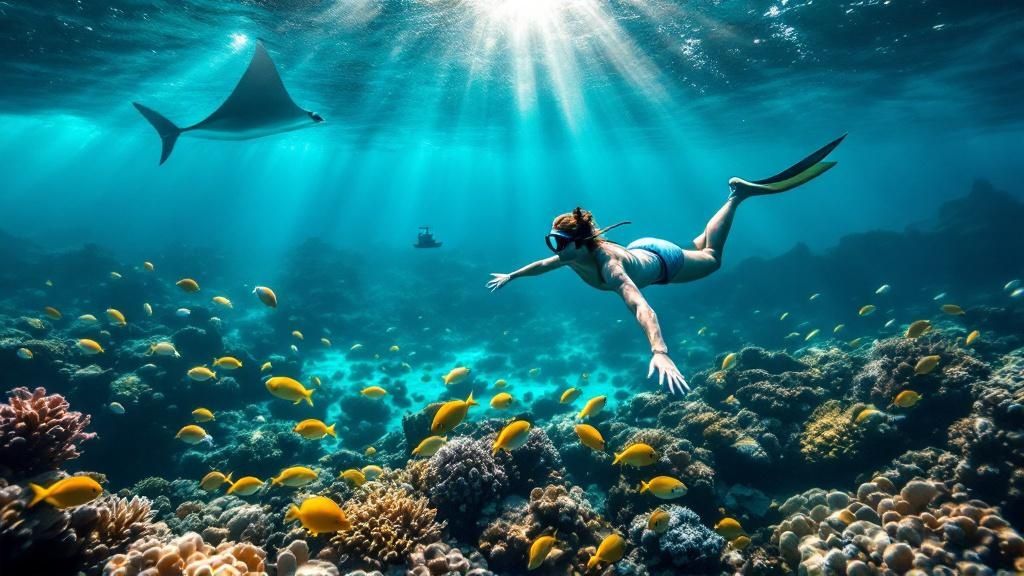
The Big Island of Hawaii is an underwater paradise, boasting some of the most vibrant coral reefs and diverse marine ecosystems in the world. From the crystal-clear waters of Kealakekua Bay to the otherworldly glow of a manta ray night snorkel, finding the perfect spot can transform your vacation into an unforgettable adventure. This guide cuts through the noise to deliver a curated list of the absolute best snorkeling Big Island has to offer, detailing seven incredible locations that cater to every skill level and interest.
We'll provide insider tips on accessibility, what you'll see, and how to make the most of your aquatic journey, whether you're a seasoned snorkeler or a first-timer. For those seeking guided experiences, Kona Snorkel Trips stands out as the top-rated and most-reviewed snorkel company in all of Hawaii, ensuring your adventure is safe, memorable, and expertly led. Here is what customers are saying:
Beyond the Big Island's vibrant underwater world, enthusiasts may wish to explore other renowned marine destinations like Australia's Coral Coast for more breathtaking oceanic adventures. Now, let's explore the spots that make the Big Island a world-class snorkeling destination.
1. Kealakekua Bay (Captain Cook Monument): The Crown Jewel of Big Island Snorkeling
Often hailed as the undisputed champion of the best snorkeling Big Island has to offer, Kealakekua Bay is a must-visit destination for any underwater enthusiast. This historically significant bay, where Captain James Cook first landed in 1779, is a protected Marine Life Conservation District. Its unique geography naturally shields it from strong ocean currents and winds, creating an exceptionally calm and clear aquatic sanctuary that feels like a natural aquarium. The result is consistently phenomenal visibility, often exceeding 100 feet, and an almost unbelievable density of marine life.
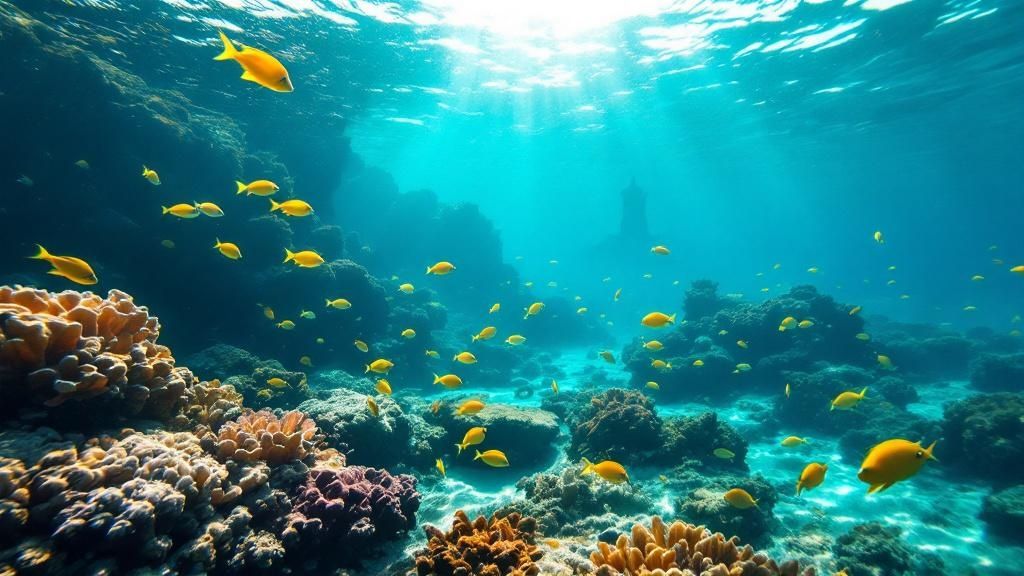
Why It's a Top Snorkeling Spot
The main snorkeling area is located across the bay from its only boat ramp, right in front of the white Captain Cook Monument. The water here is deep blue and teeming with vibrant coral gardens and massive schools of fish. You can expect to see everything from yellow tang and butterflyfish to parrotfish and spinner dolphins, which frequently visit the bay to rest. The steep underwater drop-off allows for diverse habitats, attracting a wide array of species in a relatively small area.
How to Get There & Insider Tips
While the bay itself is a snorkeler's paradise, accessing it requires some planning. Direct land access is challenging, involving a strenuous 3.8-mile round-trip hike down a steep, exposed trail. Because of this, the most highly recommended and enjoyable method is to arrive by boat.
A guided tour not only eliminates the difficult trek but also enhances the experience with expert knowledge and all necessary gear. Kona Snorkel Trips offers a top-rated Captain Cook Tour that provides a seamless and unforgettable journey to this premier location.
- Book a Tour: This is the easiest and most popular option. Tours fill up quickly, especially in peak season, so book in advance.
- Hike Smart: If you choose the trail, start very early (before 7 AM) to avoid the intense sun. Bring at least 2 liters of water per person and wear sturdy shoes.
- Best Time to Go: Mornings typically offer the calmest water and best lighting for underwater visibility and photography.
- Respect the 'Aina (Land): Enter the water gently to avoid disturbing the coral and sediment. Remember, this is a protected and sacred site.
2. Honaunau Bay (Two Step): The Most Accessible Underwater Paradise
For snorkelers seeking convenience without compromising on quality, Honaunau Bay, affectionately known as "Two Step," is a prime contender for the best snorkeling Big Island can offer. Located directly adjacent to the culturally rich Puʻuhonua o Hōnaunau National Historical Park, this spot earns its nickname from the natural lava rock ledges that form two convenient steps into the water. This unique entry point makes it exceptionally accessible for snorkelers of all ages and abilities, from young families to seasoned underwater explorers.
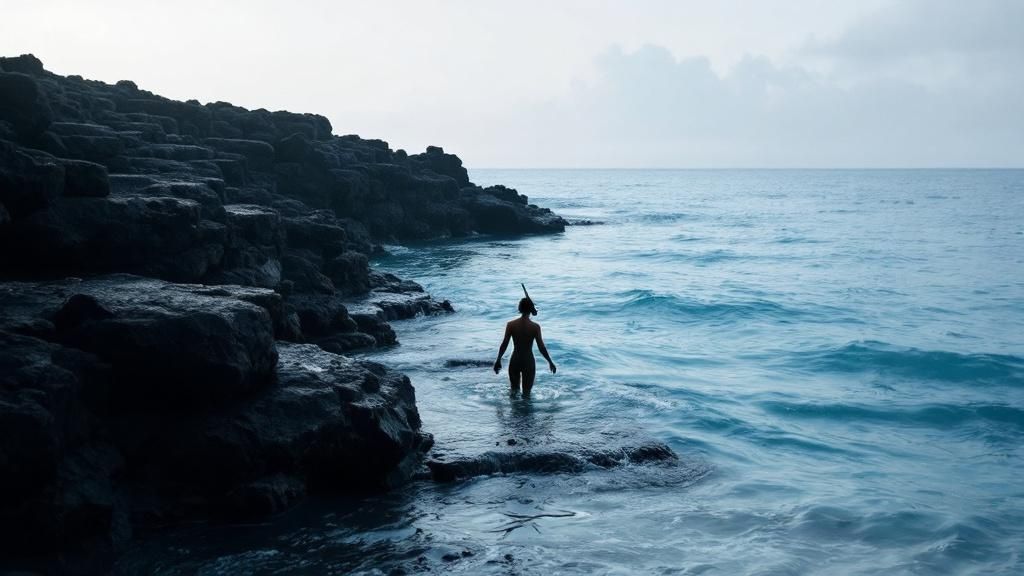
Why It's a Top Snorkeling Spot
Two Step is celebrated for its consistently calm and clear conditions, protected by the bay's natural shape. The shallow areas feature intricate coral formations and an abundance of reef fish, while the deeper parts of the bay often host resting spinner dolphins and Hawaiian green sea turtles (honu). The underwater topography is a fascinating mix of coral gardens, lava tubes, and small sea arches, providing endless nooks to explore. Its reputation as a safe and vibrant location makes it a go-to spot for local families and is often recommended by guides as the best place for beginners to get comfortable in the water.
How to Get There & Insider Tips
Honaunau Bay is easily reached by car, with a small parking area available. However, its popularity means that a little planning goes a long way to ensure a great experience. While the accessibility is a major plus, a guided tour can elevate your day by taking you to other premier spots like Kealakekua Bay on the same trip, combining the best of both worlds with expert guidance and gear.
- Arrive Early: Get there before 8 AM to secure a parking spot and enjoy the water before the midday crowds arrive.
- Wear Water Shoes: The lava rock is sharp. Protect your feet by wearing reef-safe water shoes or booties for entry and exit.
- Respect the Wildlife: Keep a respectful distance from all marine life, especially the honu. Maintain at least 10 feet of space and never touch them.
- Combine Your Visit: Plan to spend some time exploring the incredible Puʻuhonua o Hōnaunau National Historical Park next door for a full day of cultural and natural discovery.
- Bring Gear: While there are often rental vans nearby, bringing your own snorkel gear will save you time and money.
3. Kahalu'u Beach Park: The Perfect Spot for Beginners and Turtle Lovers
For snorkelers seeking accessibility and an abundance of marine life in a protected environment, Kahalu'u Beach Park is a standout choice. Known as one of the most reliable and family-friendly spots for the best snorkeling Big Island offers, this location is perfect for beginners and seasoned swimmers alike. A large breakwater, built by ancient Hawaiians, creates a calm, shallow bay shielded from ocean swells, ensuring safe and easy conditions nearly year-round. It's renowned for being one of the best places on the island to see Hawaiian green sea turtles (honu) grazing peacefully on algae.
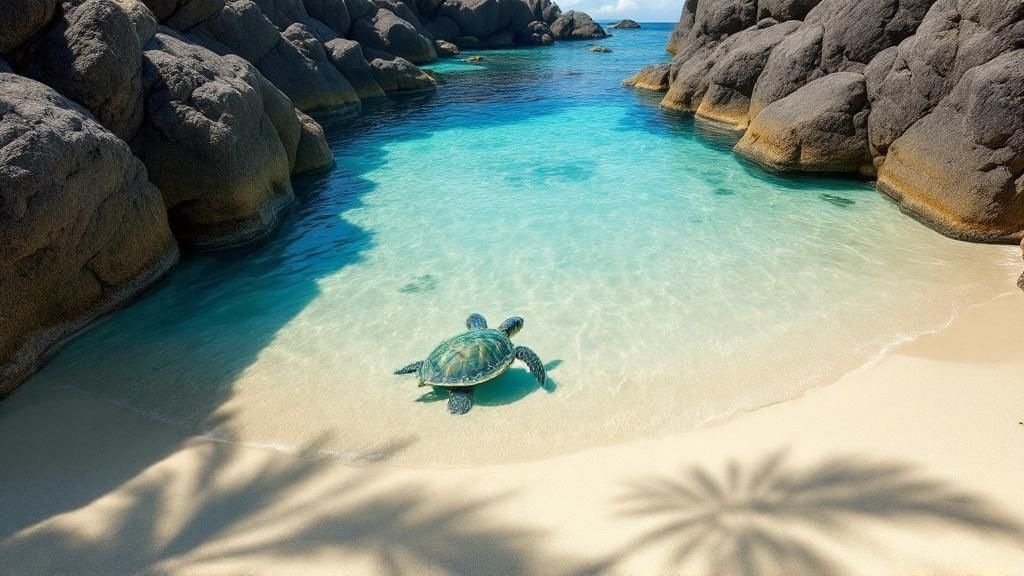
Why It's a Top Snorkeling Spot
Kahalu'u is essentially a natural aquarium with easy entry. The shallow waters on the left (south) side of the bay are ideal for children and first-time snorkelers to get comfortable. The extensive coral reef hosts an incredible diversity of fish in surprisingly shallow depths. You'll be surrounded by schools of butterflyfish, parrotfish, and Moorish idols. The Kahalu'u Bay Education Center on-site offers valuable information about the delicate ecosystem and how to interact with it responsibly, and active reef restoration projects ensure its health for future generations.
How to Get There & Insider Tips
Located just south of Kailua-Kona, Kahalu'u Beach Park is easily accessible by car and features facilities like restrooms, showers, and a lifeguard tower. Due to its popularity, planning ahead can greatly enhance your visit. This spot is less about a guided tour and more about a DIY beach day, but a little local knowledge goes a long way.
- Go Early: Arrive before 9 AM to secure a parking spot and enjoy the best water clarity before the crowds arrive and stir up sediment.
- Respect the Wildlife: It is crucial to give Hawaiian green sea turtles at least 10-15 feet of space and never touch them. Also, avoid standing on or touching the fragile coral.
- Use Reef-Safe Sunscreen: Protect the vibrant reef by using only mineral-based sunscreens (zinc oxide or titanium dioxide).
- Check Tides: Snorkeling is best during high tide when there is more water covering the reef, making it easier to swim over the coral without causing damage. You can learn more about the incredible creatures you'll see with this handy Hawaii reef fish guide.
4. Kiholo Bay: A Turquoise Oasis with Unique Encounters
For those seeking an off-the-beaten-path adventure, Kiholo Bay offers a truly unique and serene experience, making it a hidden gem for some of the best snorkeling Big Island provides. This stunning bay is famous for its almost surreal turquoise water, a result of freshwater springs bubbling up from underground and mixing with the saltwater of the ocean. This brackish lagoon, combined with ancient lava flows and black sand beaches, creates a breathtaking landscape and a one-of-a-kind aquatic ecosystem.
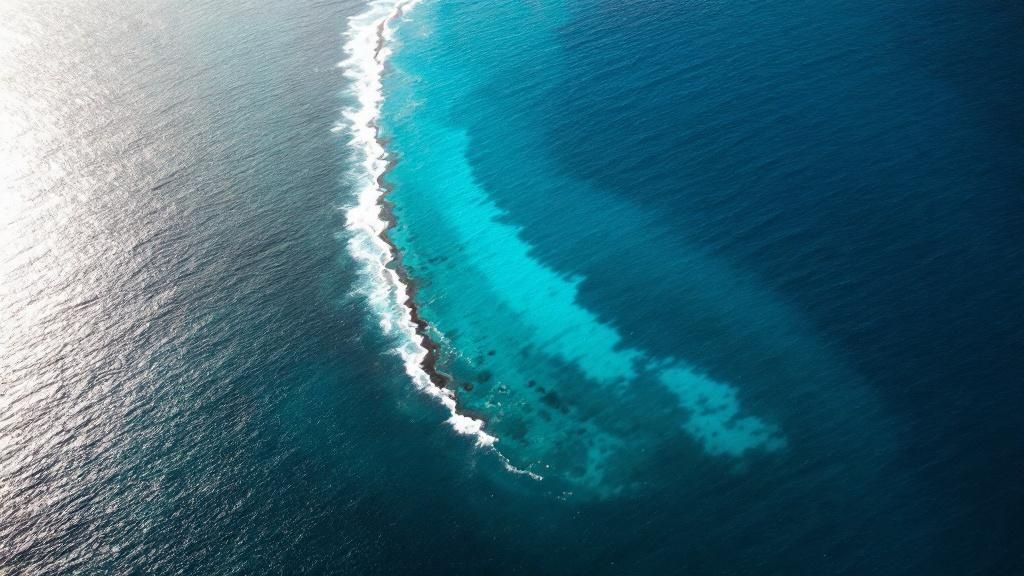
Why It's a Top Snorkeling Spot
The main draw of Kiholo Bay is its otherworldly clarity and the high probability of encountering honu (Hawaiian Green Sea Turtles). The turtles are drawn to the calm, protected waters and the abundant limu (seaweed) that grows here. Snorkeling in the main channel or near the freshwater inlets allows you to glide alongside these gentle giants in their natural habitat. The unique mix of fresh and saltwater also attracts different fish species than you might find in purely marine environments, offering a distinct and memorable snorkel.
How to Get There & Insider Tips
Accessing Kiholo Bay requires a bit of effort, which helps keep the crowds away. The unpaved access road is best suited for a 4WD vehicle, though many 2WD cars can manage if driven carefully. From the parking area, it’s a 15-20 minute walk across lava rock and sand to reach the prime snorkeling areas. Preparation is key to enjoying this pristine location safely.
- Go Prepared: There are no facilities. Bring all your own snorkeling gear, reef-safe sunscreen, and plenty of water.
- Sturdy Footwear: The hike involves walking over uneven lava rock. Wear sturdy shoes or hiking sandals, not just flip-flops.
- Time Your Visit: Start early in the morning to avoid the midday heat on the exposed hike and to enjoy the calmest water conditions.
- Leave No Trace: This is a precious and fragile environment. Pack out everything you bring in to help preserve its beauty.
- Safety First: The terrain and remote nature of the bay mean you need to be extra cautious. Review some fundamental snorkeling safety tips before you go.
5. Lapakahi State Historical Park: A Snorkel Through Hawaiian History
For a truly unique experience that blends incredible underwater exploration with a deep dive into Hawaiian culture, Lapakahi State Historical Park is an unmatched destination. Located on the rugged North Kohala coast, this park protects the partially restored ruins of an ancient Hawaiian fishing village that is over 600 years old. The adjacent waters are a Marine Life Conservation District, offering some of the best snorkeling Big Island provides for those seeking solitude and pristine conditions away from the more crowded Kona-side spots.
Why It's a Top Snorkeling Spot
Lapakahi offers a glimpse into a healthier, more robust reef system, largely untouched by heavy tourism. The protected cove features excellent visibility and a healthy coral population that attracts a diverse array of marine life. Here, you can float above cauliflower coral heads, spot schools of convict tangs, and possibly encounter moray eels or even a resting sea turtle. What makes it special is the ability to snorkel in a place of immense historical significance, connecting with the same waters that sustained a thriving Hawaiian community centuries ago.
How to Get There & Insider Tips
Lapakahi is located off Highway 270 in North Kohala, about a 45-minute drive north of the main resort areas. Access is straightforward via a paved road into the park, but the snorkeling experience requires preparation as there are no facilities or services on site.
- Combine Culture and Snorkeling: Start with the self-guided walking tour through the village ruins to appreciate the history before you enter the water. It provides context that enriches the entire visit.
- Rocky Entry: The entry point at Koai'e Cove is very rocky and can be slippery. Sturdy water shoes or reef-safe booties are essential for safe entry and exit.
- Check Conditions: This area is more exposed than Kona's bays. Always check the wind and surf reports before you go, as conditions can become rough and unsafe, particularly in the winter.
- Pack Everything In: There are no food, water, or rental facilities. You must bring all your own gear, plenty of water, and snacks or a packed lunch.
- Respect the Site: This is a sacred archaeological site. Do not touch, move, or stand on any of the rock walls or historical structures. Tread lightly and leave no trace.
6. Mauna Kea Beach (Kaunaʻoa Beach): Picture-Perfect Snorkeling
Regularly featured on "World's Best Beaches" lists, Mauna Kea Beach, officially known as Kaunaʻoa Beach, is a stunning crescent of soft white sand fronting the luxurious Mauna Kea Beach Hotel. While it boasts an exclusive feel, public access is provided, making it one of the premier spots for the best snorkeling Big Island offers in a classic resort setting. Its protected cove-like shape ensures the turquoise waters are often calm, clear, and ideal for families and snorkelers of all skill levels.
Why It's a Top Snorkeling Spot
The magic of Mauna Kea Beach lies at its rocky edges. While the sandy center is perfect for swimming, the real underwater show is found along the rocky outcrops at the northern (right) and southern (left) ends of the bay. These areas are home to developing coral formations that attract a wonderful variety of marine life, including butterflyfish, surgeonfish, wrasse, and occasionally, graceful sea turtles gliding by. The excellent visibility and gentle conditions make it a fantastic location for underwater photography; you can find great tips on how to take underwater pictures to capture your memories here.
How to Get There & Insider Tips
Accessing this slice of paradise requires a bit of strategy due to extremely limited public parking. The beach is part of the Mauna Kea Beach Hotel property, which provides a small lot for non-guests.
- Arrive Early: The public lot has only about 20-30 spaces. To secure a spot, you must arrive before 8 AM, especially on weekends and holidays.
- Check-in at the Gate: Tell the security guard at the resort entrance you are going to the public beach. They will give you a parking pass if spots are available.
- Target the Rocks: For the best snorkeling, enter the water from the sand and swim towards the rocky points at either end of the beach. The right side is often considered slightly better.
- Come Prepared: Public amenities are limited to showers and restrooms. Bring your own snorkel gear, reef-safe sunscreen, food, and water to avoid high resort prices.
7. Richardson's Beach Park (Leleiwi Beach): A Unique Hilo Gem
For those exploring the lush windward side of the island, Richardson's Beach Park offers a distinct and rewarding experience, making it a strong contender for the best snorkeling Big Island has on its Hilo coast. Known to locals as Leleiwi Beach, its striking black sand, formed from ancient volcanic activity, creates a dramatic backdrop for a family-friendly snorkeling adventure. Natural lava rock seawalls form protected pools, providing calm, clear waters that are perfect for beginners and children.
Why It's a Top Snorkeling Spot
Unlike the deep blue drop-offs of the Kona coast, Richardson's charm lies in its shallow, accessible tide pools and sheltered coves. The dark volcanic rock and black sand make the vibrant colors of the fish pop, offering incredible visual contrast. This park is particularly famous for being a frequent resting spot for Hawaiian Green Sea Turtles (honu), which can often be seen basking on the warm black sand or gliding gracefully through the water. It’s an ideal spot for schools conducting marine biology field trips and families wanting a safe, educational, and beautiful beach day.
How to Get There & Insider Tips
Richardson's is located just a few miles from downtown Hilo and is very easy to access by car, with ample parking and excellent facilities including restrooms, showers, and picnic areas. Its convenience and unique environment make it a beloved local hangout.
- Timing is Key: Hilo is known for its rain. Visit in the morning for the highest chance of sunny skies and calm conditions before the typical afternoon showers roll in.
- Explore the Tide Pools: The best marine life viewing is often in the shallow tide pools, especially during low tide. Look for small fish, crabs, and other crustaceans hiding in the lava rock crevices.
- Protect Your Feet: The black sand can get extremely hot under the Hawaiian sun. Always wear water shoes or sandals when walking on the beach.
- Stay Safe: While the main areas are protected, currents can be strong outside the lava rock barriers. Less experienced swimmers should stay within the sheltered coves.
- Pack Accordingly: The east side is often cooler and breezier than Kona. It's a good idea to bring a light jacket or long-sleeved shirt for after your snorkel.
Top 7 Snorkeling Spots Comparison
| Snorkeling Spot | Implementation Complexity 🔄 | Resource Requirements ⚡ | Expected Outcomes 📊 | Ideal Use Cases 💡 | Key Advantages ⭐ |
|---|---|---|---|---|---|
| Kealakekua Bay | Moderate to Difficult (steep hike, boat tours) | High (boat tours expensive, strenuous hike) | Exceptional water clarity and abundant marine life | Experienced snorkelers, marine life enthusiasts | Best water clarity, abundant tropical fish, dolphins, protected area |
| Honaunau Bay (Two Step) | Easy (natural lava steps, shore entry) | Low (free access, minimal gear needed) | Good marine diversity with calm waters | Families, beginners, casual snorkelers | Easy entry, calm waters, free access, family-friendly, sea turtles |
| Kahalu'u Beach Park | Very Easy (lifeguarded, full facilities) | Moderate (gear rental, parking) | Safe snorkeling with reliable turtle sightings | Beginners, families, casual snorkelers | Lifeguards, facilities, guaranteed turtle sightings, close to town |
| Kiholo Bay | Moderate (20-30 min hike over lava terrain) | Moderate (bring own gear, no facilities) | Unique brackish water, clear but less diverse life | Photographers, solitude seekers, turtle viewers | Unique turquoise water, fewer crowds, sea turtles, scenic |
| Lapakahi State Historical Park | Moderate to Difficult (remote, rough entry) | Low (no services, self-guided tour) | Excellent snorkeling plus cultural education | Advanced snorkelers, culturally interested visitors | Cultural history, minimal crowds, well-preserved reefs |
| Mauna Kea Beach | Easy (limited parking, resort area) | Moderate to High (resort proximity, parking issues) | Beautiful beach, good snorkeling at rocky points | Families, luxury travelers, beach lovers | Pristine white sand, calm waters, luxury amenities, professional services |
| Richardson's Beach Park | Easy (facilities available, lava rock entry) | Low (free access, full facilities) | Family-friendly snorkeling, tide pools, turtles | Families, local visitors, tide pool explorers | Unique black sand beach, tide pools, lifeguards, less crowded |
Your Guide to the Big Island’s Ultimate Underwater Adventures
The Big Island of Hawaii offers a snorkeling experience unlike any other on the planet. Its geologically young and dynamic coastline, shaped by volcanic activity, has created a diverse tapestry of underwater landscapes. From the serene, protected waters of Kealakekua Bay, rich with history and vibrant coral, to the easy-access, turtle-filled shallows of Kahalu'u Beach Park, each location on our list provides a unique window into the Pacific's marine ecosystem. You now have a comprehensive guide to the best snorkeling Big Island has to offer, equipping you with the knowledge to choose your perfect adventure.
We've explored spots for every skill level, from the beginner-friendly "Two Step" at Honaunau Bay to the more remote and rewarding Kiholo Bay. Whether you seek the historical reverence of Lapakahi State Historical Park or the picturesque, resort-style beauty of Mauna Kea Beach, the island delivers. Your journey is not just about seeing fish; it's about immersing yourself in environments teeming with green sea turtles, colorful reef fish, and the occasional spinner dolphin.
Final Takeaways for Your Snorkeling Success
To truly make the most of your time, remember these key principles:
- Go Early: The best conditions, with calmer waters and better visibility, are almost always found in the morning before the afternoon winds pick up. This also helps you avoid the biggest crowds.
- Safety First: Always snorkel with a buddy, be aware of your surroundings, and never touch the coral or marine life. Using reef-safe sunscreen is non-negotiable to protect the delicate ecosystems you've come to enjoy.
- Choose Wisely: Match the snorkel spot to your comfort and skill level. A challenging entry or potentially strong currents can ruin a day if you're not prepared. For spots like Kealakekua Bay, booking a guided tour is often the safest and most enriching option.
- Embrace the Magic: While a checklist of must-see spots is great, some of the best moments happen when you simply float, listen to the crackle of the reef, and watch the underwater world go by.
A Special Mention: The Unforgettable Manta Ray Night Snorkel
While our list covers the best daytime spots, no guide to the best snorkeling Big Island has to offer is complete without highlighting the world-famous Manta Ray Night Snorkel. This is a truly once-in-a-lifetime experience. After sunset, specialized boats take you to a designated site where powerful, eco-friendly lights are shone into the water. This light attracts swarms of plankton, the primary food source for manta rays.
You'll float effortlessly on the surface, holding onto a custom-built light board, and watch in absolute awe as these gentle giants glide, swoop, and perform mesmerizing barrel rolls just inches below you. It's a breathtaking, magical, and completely safe encounter with creatures boasting wingspans up to 16 feet. Many who experience it call it the single most memorable activity of their Hawaiian vacation.
For this unique adventure, we highly recommend the Manta Ray Night Snorkel tour from Kona Snorkel Trips. Their expert guides, commitment to small group sizes for a personalized feel, and unwavering focus on safety make them the top choice for this incredible experience.
You can find more details on their tour here: Manta Ray Snorkel Kona. Don't miss out on what is consistently ranked as one of the best night dives and snorkels in the world.
The Big Island's coastline is a treasure trove of underwater wonders. Whether you choose a historic bay, a bustling beach park, or a magical nighttime encounter, you're now ready to create memories that will last a lifetime. Grab your fins and mask, and get ready to explore!
Ready to turn these plans into reality with a trusted, top-rated guide? For an unparalleled experience exploring Captain Cook or swimming with gentle giants on the manta ray night snorkel, book your next adventure with Kona Snorkel Trips. As Hawaii's most reviewed and highest-rated snorkel company, their expert crew and small-group tours ensure your time on the water is safe, memorable, and absolutely unforgettable.
